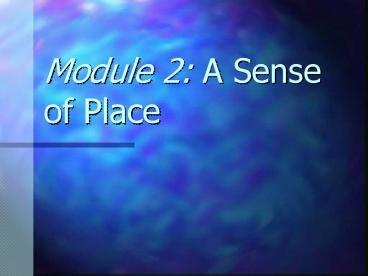Module 2: A Sense of Place - PowerPoint PPT Presentation
1 / 24
Title:
Module 2: A Sense of Place
Description:
Describe early contacts between Aborigines and Asian visitors ... Aborigines on the northern coast of Australia had annual contact with Asian ... – PowerPoint PPT presentation
Number of Views:103
Avg rating:3.0/5.0
Title: Module 2: A Sense of Place
1
Module 2 A Sense of Place
2
AAP on the Web
- Go to USQ Connect
- http//www.usq.edu.au/course/material
- Then click on AST 1000
- Lecture slides will be put up after the lecture
has been delivered
3
The big regional picture .
- We can identify a range of events and issues
which link Australia to nations and peoples of
the Pacific - War in Afghanistan, Bali bombing, people
smuggling, human rights issues, Asian economic
crisis impact on Australia, education links
(overseas students in Australia), strong economic
relations, Fiji coup, Bouganville crisis, boat
people - These points provide the background for AAP
4
Our Objectives in Module 2 Part II
- Have a look at page 2.2 in the Study Book where
our objectives are listed. - Module objectives are listed at the beginning of
every module in the Study Book - Objectives are important for you they state what
you are expected to know or what you are expected
to be able to do
5
Our Objectives in Module 2 Part II
- After Studying this module you should be able
to - Describe early contacts between Aborigines and
Asian visitors - Outline 18th century European perceptions of Asia
Pacific landscapes and people - There are more please read
6
Overview
- In this module, our attention is on
- The ideas
- The prejudices
- The knowledge
- The fantasies
- European Australians have had, and perhaps still
have about Asia and the Pacific
7
Classical geographer Ptolemy
- Imagined the Asia Pacific region as
- A fantastic world
- Wonderfully rich
- Full of rare animals
- Asia and the Pacific were fantastic, exotic,
fabulous
8
An Indigenous Sense of Asia
- Aborigines on the northern coast of Australia had
annual contact with Asian fishermen for 200-300
years - Fishermen from Macassar (now Ujung Pandang in
Sulawesi) loaded up with trepang the sailed home
on the South East winds
9
Aborigines and the Macassans exchanged
- Makasans offered
- Steel axes and knives
- Food
- Alcohol
- Cloth
- Tobacco
- Canoes
- Aborigines offered
- Labour
- Local knowledge
- Relationships
10
Cultural Influences
- We all carry cultural luggage the ideas, values
and beliefs that have influenced us and which
affect our behaviour - Twenty first century Australians, for example,
are influenced by environmentalism - This is evident from our laws, conferences,
university courses, jobs available, green
politics, government budgets, research into
clean cars and so on
11
18th century European ideas of Asia and the
Pacific
- Europeans cultural luggage was complex and
varied. They were influenced by - Ptolemy
- The Enlightenment
- Primitivism
- Progressivism
- Scientific Empiricism
- Evangelical Christianity
12
Primitivism
- Owed a lot to Greek and Roman ideas
- Idealised the natural life
- Understood the luxuriant vegetation of the
Pacific and Southeast Asia as like the garden of
Eden
13
Progressivism
- More materialistic, stressed the development of
material wealth - Evaluated other cultures in terms of their
commercial and trading development
14
Evangelical Christianity
- Assumed an obligation to spread the gospel by
missionary activity
15
Geographical Determinism
- A belief that climate had a direct affect on
humans health and energy - Assumed that whites were not well suited to
laboring in the tropics
16
Scientific Empiricism
- A belief that knowledge is built through
exploration, direct experience, testing of
assumptions - Promotes attitudes of curiosity and interest in
new places and people
17
Lord Monboddos Chain of Being
- Monboddo believed that all life was arranged in a
vast chain of life - Divine beings were at one end of the chain,
degraded beasts and brutes at the other end - Great empires were up top
- Bands and clan societies he considered to be a
lower form of existence
18
The Noble Savage
- Primitivism idealised the native populations of
the Pacific and New Holland - Natives were seen as noble savages living
innocent lives in paradise
19
Cult of the Noble Savage Criticised
- Explorers found that primitivism had ignored
- Prostitution
- Infanticide
- Cannibalism
- Hierarchical structures
20
Colonial Images of Progressivism
- Colonial painting and poetry expressed
Progressivist views very clearly - Settler achievements were contrasted with what
was seen as a lack of achievement amongst
Aborigines - Settlers drew attention to the lack of a built
landscape
21
Summary
- I have described the intellectual background to
Europeans sense of - Racial superiority (Lord Monboddo)
- Technological superiority (Progressivism)
- Cultural/Spiritual superiority (Evangelical
Christianity)
22
Summary
- And Europeans intense fascination with Asian and
Pacific social and cultural organisation - This background has left Europeans with a tension
between attitudes of disdain (superiority) and
attitudes of fascination
23
Contemporary Images and Perceptions of Asia and
the Pacific
- Do images in popular magazines contribute to
ethnocentric, dismissive, patronising attitudes?
24
Review of Objectives
- Take a moment to think .
- Can you now describe early contacts between
Aborigines and Asian visitors? - Can you now outline 18th century European
perceptions of Asia Pacific landscapes and
people?































